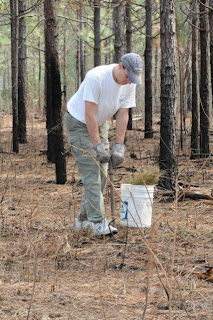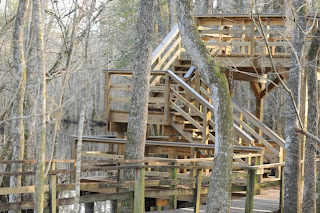
Everyone has likely dibbled at least once in their life. The dibble is a garden tool used to make a hole in the ground for the purpose of planting, while to dibble is the act of making said hole in the ground. The image shows the equipment used to make some of the 15,000 holes for the Wiregrass (Aristida stricta) plugs (see yesterday's entry) in the Francis Beidler Forest's Longleaf Pine (Pinus palustris) plots. The dibble is the metal tool and the bucket contains the grass plugs. A weary planter noted that the bucket full of grass reminded him of Tom Hanks' imaginary friend, Wilson, in Cast Away.
To plant manually using the dibble, one selects a spot on the ground at least three feet from the last Wiregrass plug and steps on the metal projection above the blade in order to push the dibble  blade into the ground. Next, one moves the dibble slightly towards and away from one's body in order to widen the hole. If one is lucky enough to have a partner carrying the bucket of grass plugs, the partner drops the plug in the hole and the dibble is inserted into the ground near the hole to close the hole around the plug. Repeat until all 15,000 grass plugs are planted!
blade into the ground. Next, one moves the dibble slightly towards and away from one's body in order to widen the hole. If one is lucky enough to have a partner carrying the bucket of grass plugs, the partner drops the plug in the hole and the dibble is inserted into the ground near the hole to close the hole around the plug. Repeat until all 15,000 grass plugs are planted!
 blade into the ground. Next, one moves the dibble slightly towards and away from one's body in order to widen the hole. If one is lucky enough to have a partner carrying the bucket of grass plugs, the partner drops the plug in the hole and the dibble is inserted into the ground near the hole to close the hole around the plug. Repeat until all 15,000 grass plugs are planted!
blade into the ground. Next, one moves the dibble slightly towards and away from one's body in order to widen the hole. If one is lucky enough to have a partner carrying the bucket of grass plugs, the partner drops the plug in the hole and the dibble is inserted into the ground near the hole to close the hole around the plug. Repeat until all 15,000 grass plugs are planted!Fortunately, we also have a mechanical planter that is able to run in the space between the rows of pine trees. One person drives the tractor and one person sits on the planter. As the tractor pulls the planter, the planter's spreader opens a trough below the seated individual. After the person on the planter drops a grass plug into the trough, the back end (wheels) of the planter pushes the sides of the trough together thereby sealing the grass plug into the ground.



With slightly more than a third of the grass plugs planted on each of the first two days, there will be plenty of plugs remaining for some Saturday fun!


Images by Mark Musselman








































